Austin Distance Challenge 2021-2022: A Hopefully Logical Approach to the Insanity of Running Six Races in Six Months as I turn Sixty
The title of this article is a hat tip to my plan in April 2015 to run the Pikes Peak Ascent. I did indeed survive that insanity, mostly intact, and finished the race. Six years later, with racing appearing to open up and my legs and I approaching our 60th birthday, it is time to put the plan in place for the 2021 – 2022 Austin Distance Challenge.
I’d appreciate any feedback from fellow runners on this plan, especially running a race a month at a master’s age when the body doesn’t recover as quickly.
Update 07/18/2021
- Changed the image of the race dates as all races now have a date
- Changed the table of schedule for runs, since my guesses for the races that had dates were off
- Added goals as suggested by my brother
- Updated the table with actual MPW to this date.
I have previously run the Austin Distance Challenge in 2018-2019 and in 2019-2020, but skipped the virtual races that were held during the pandemic. Those previous Austin Distance Challenges were five races. During the virtual race year and for this upcoming year, a 10K has been added to fill a gap – now making it a race a month for six months. Below is a screenshot from the Austin Distance Challenge website in May 2021 as I write this. Two races, those run by are still awaiting exact dates.
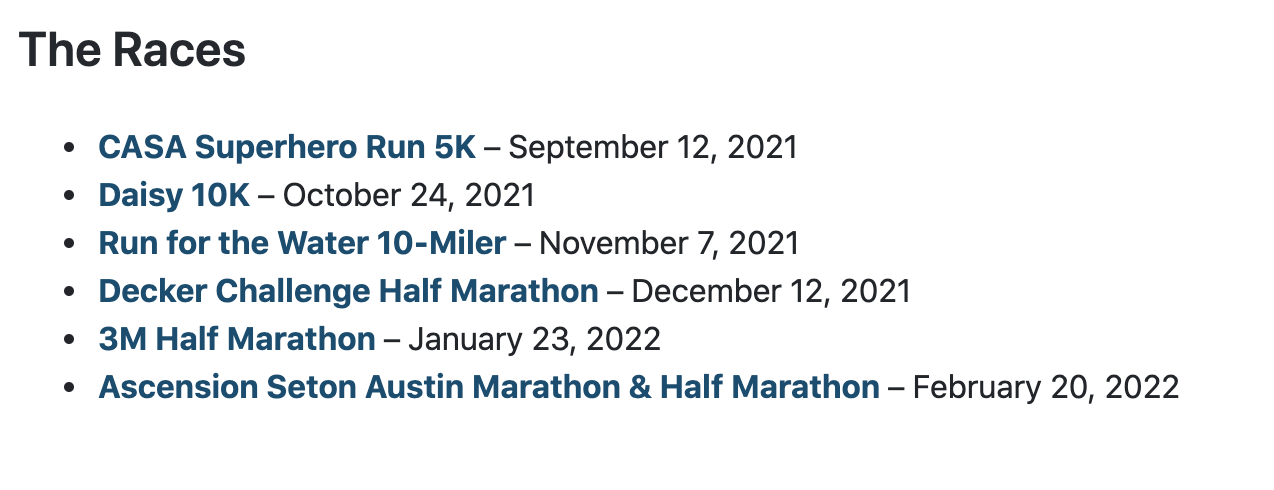
Thus there is a 5K, a 10K, a hilly ten-miler, and even hillier half-marathon (with a big damn hill), the “Downhill to Downtown” 3M Half, and runner’s choice full or half as the last race. I, suffering from only temporary bouts of insanity, run the three half marathons.
Previous Austin Distance Challenge Runs
For goals, below are the two previous attempts at the Austin Distance Challenge. The age groupings are based on the runners age at the date of the last race in the challenge –
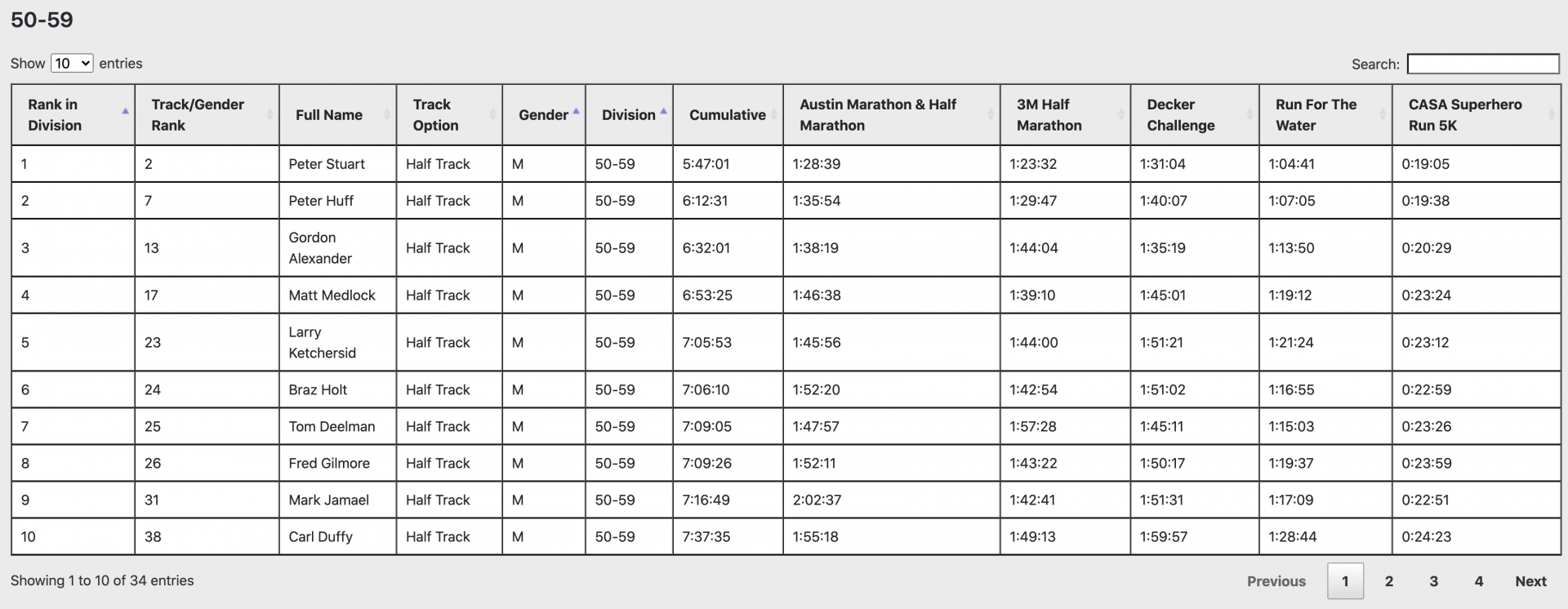
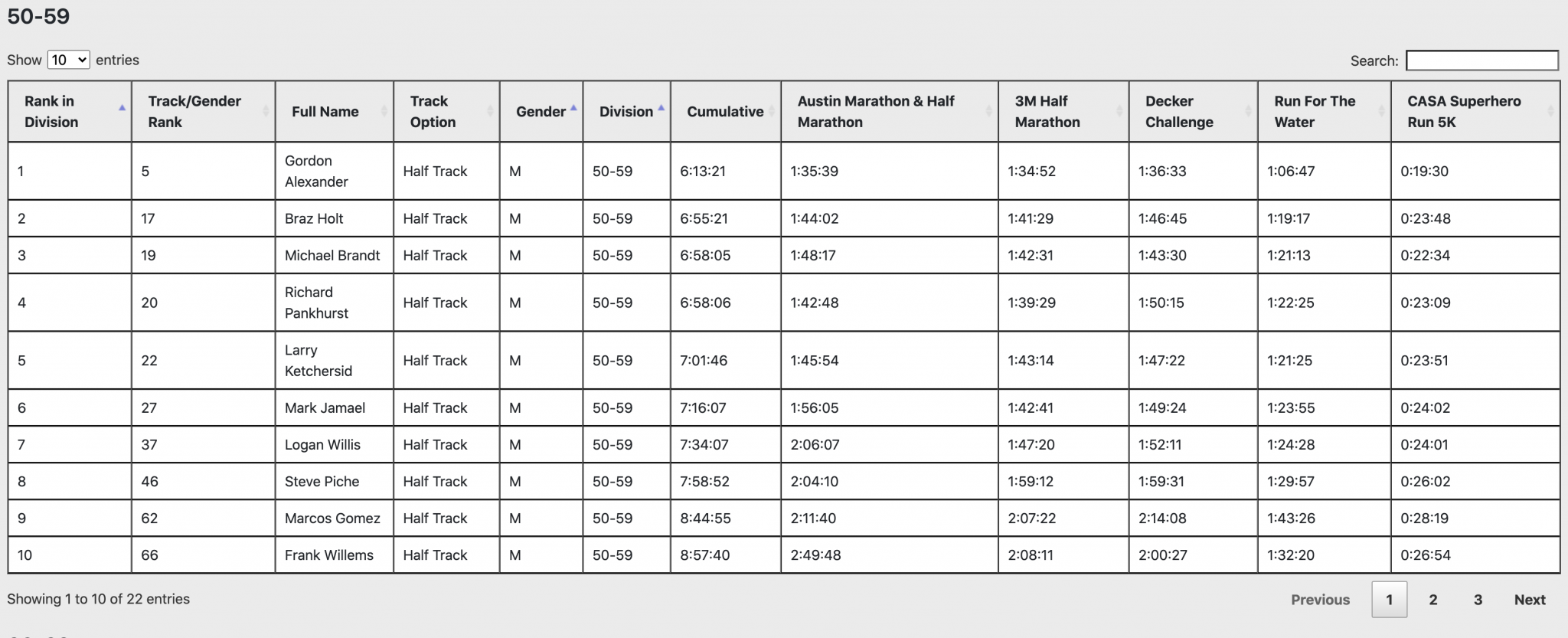
Total time for the challenge was 4:07 slower year over year (that’s 4 minutes and 7 seconds, not 4 hours and 7 minutes – I ain’t getting old that quick!). Much of that can be attributed to the Decker Challenge (that damn hill again), where my time was 4 minutes slower. Much of the other times were within reasonable proximity to the year before, some a bit faster, some a bit slower. But the goal is to always get faster, still aiming for that elusive sub-8:00 pace in the half (below 1:44:52). I hit it in the 3M, but since that one is downhill my goal is to get it in one of the non-downhill ones.
Since I started running races somewhat late in life (after rugby, basketball and other fun) the 1:43:14 in the 2019 3M is my PR in the Half, and the 1:45:54 in the Austin Half is my PR in a Half that isn’t all downhill (though there are a lot of hills in the Austin Half!). Guess I should go find a flat race eventually.
Goals
Adding a goals section at the recommendation of my brother. In order, they are:
- PR in non-3M half marathon (faster than 1:45:54 set in February 2019)
- PR in 3M Half (since it is downhill I count it as separate) (faster than 1:43:14 set in January 2019)
- Top 2 finish in age group overall
- Not running stoppages because of injury.
Training changes from previous years
I have used the Hanson’s Half Marathon program with good results in past years, and have made a few tweaks along the way to get my times down. There are several changes I am making for this plan.
Monthly/Weekly Mileage and Long Runs
Two of the pieces I’m changing go hand-in-hand – more miles, including mileage before the 18-week Hanson plan would normally start, and longer long runs. In years past after the last run of the season, my running volume has really gone down, and didn’t go back up until just before the 18-week plan would kick in (around July).
The screenshot below shows monthly mileage leading up to the 2018-2019 series. My standard practice was to take the time between racing seasons much slower, averaging 10-15 MPW. The jump from July to August was the start of that year’s Hansen 18-week schedule, and though it was ramped up week to week, I did experience some aches and pains that messed with the schedule.
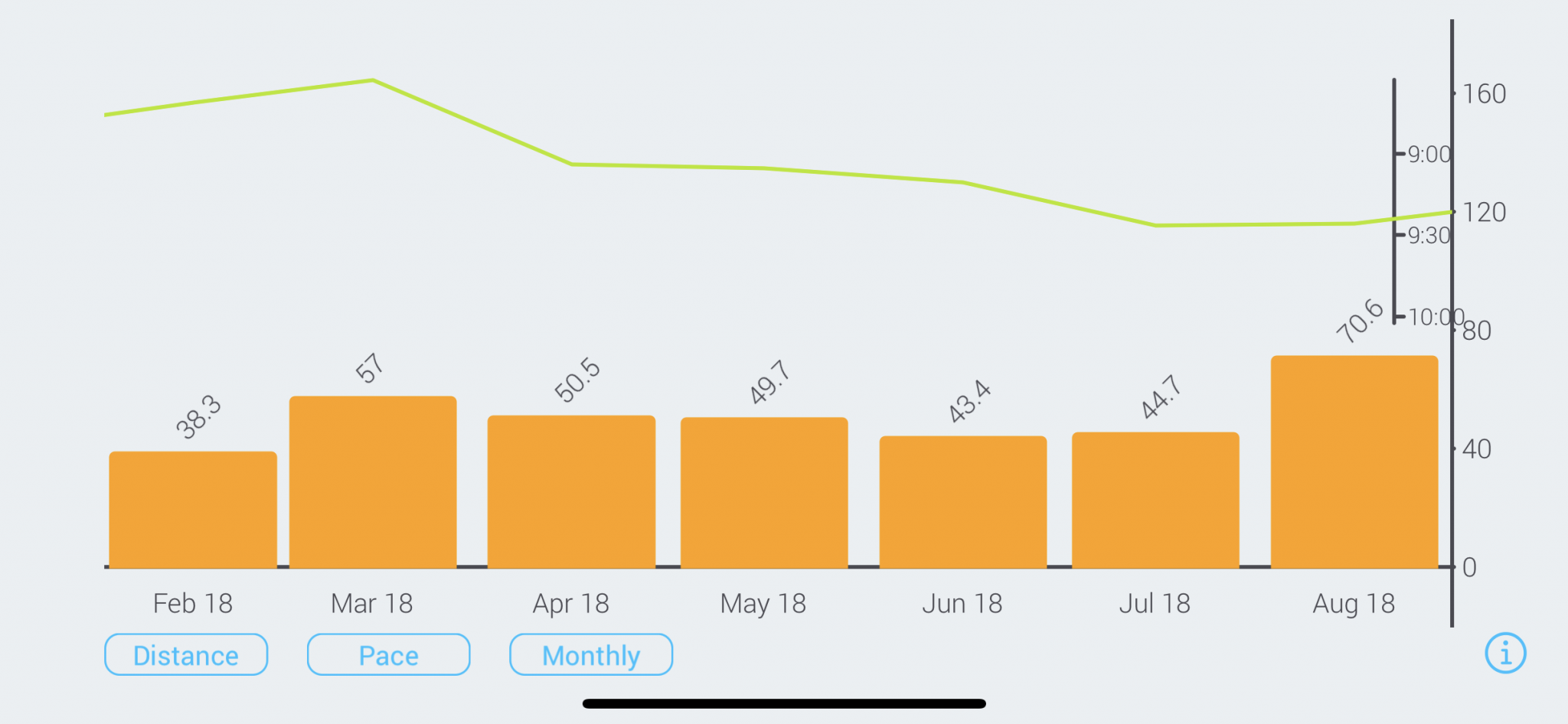
The screenshot below shows the ramp down from the 2019-2020 series (last race in February), a dip in April and July (our 30th anniversary trips!) but a bit higher mileage than before. But there was still a huge ramp from July to August 2019.
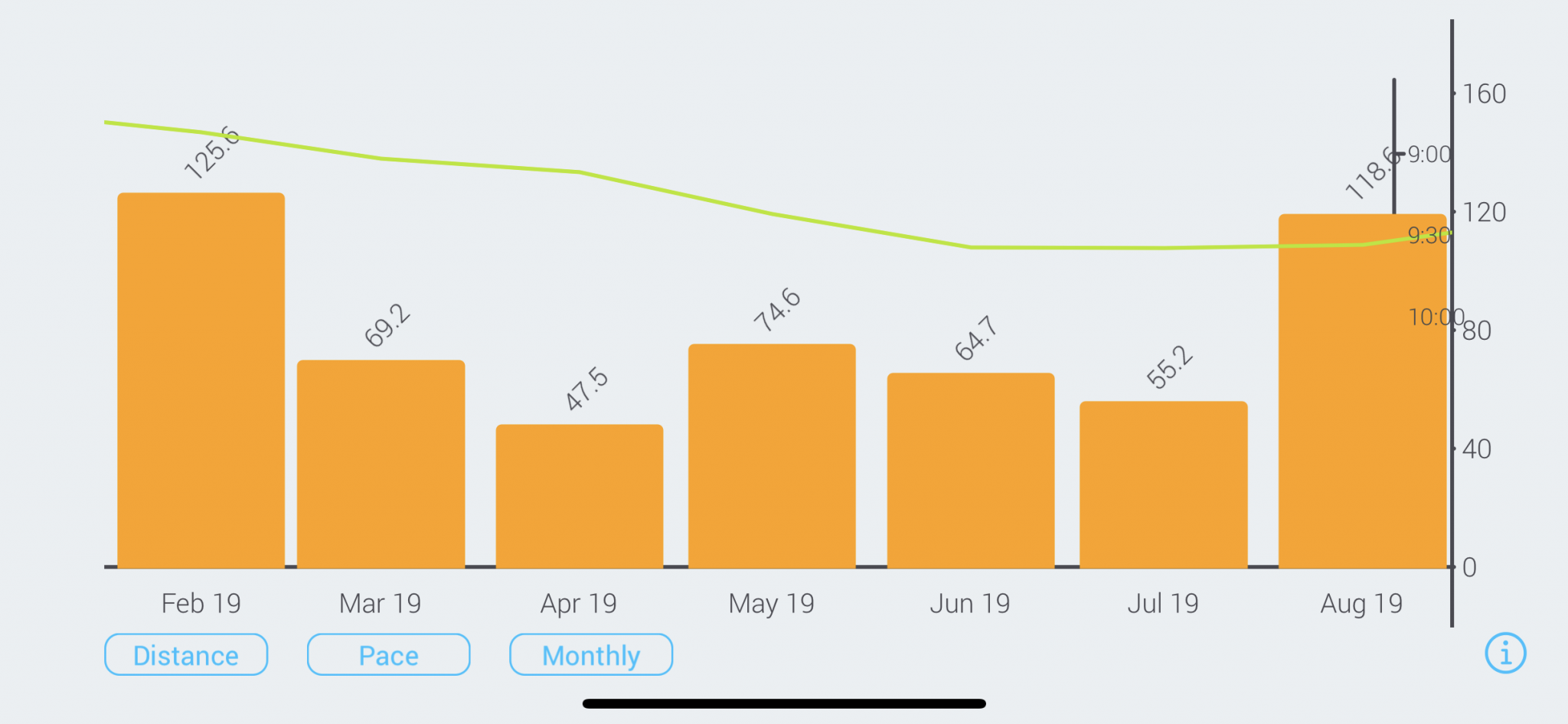
The screenshot below starts a month earlier than the previous two. Since I did not participate in the virtual races for last year’s Austin Distance Challenge, January and February’s mileage is not over 100. But as planned monthly mileage has stayed consistently over 80 (20-25 MPW) and in April through July (incomplete in the screenshot below) has increased to 30ish MPW .
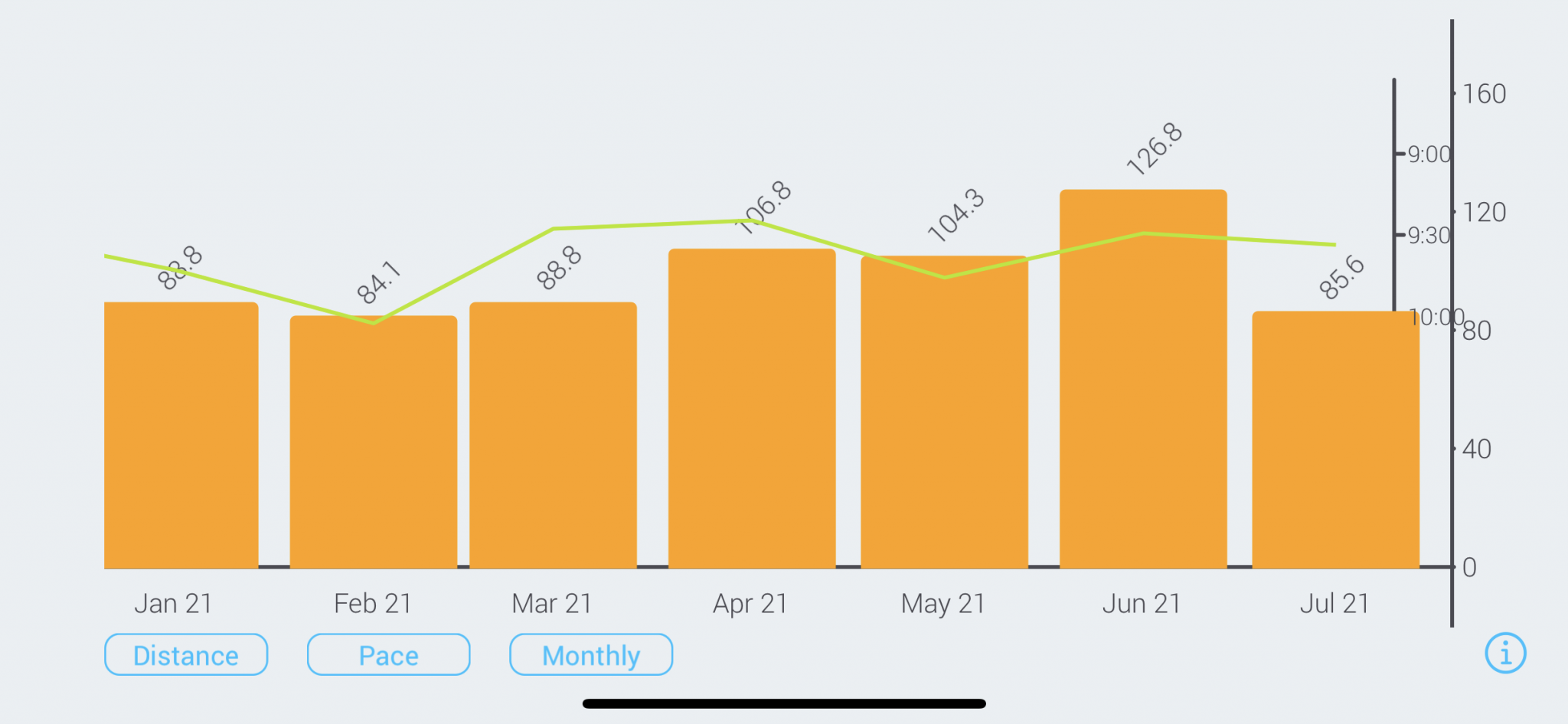
The plan is to have a longer mileage base in the 30-35 MPW range before starting the 18-week Hansen plan. Update: as of July 18, so far so good.
Similarly, long runs usually don’t start until week 5 of the Hansen plan with a 10 miler, with the longest runs of 14 not suggested until week 12. Some of these were difficult for me in years past. With the increased base earlier, longer runs can start earlier making the later long runs and races feel easier (at least that’s the plan!).
Injury Prevention and Strength Training
Like many people my age I have some past injuries that I attempt to mitigate, and some soreness that comes up with increased mileage. Two additional tactics for this year are the increase in the base mileage, and more intense (and slightly different) strength training.
When I stopped playing rugby and moved over to more cardio-oriented sports years ago, I really ramped down the strength training. This took me from 185-190 pounds to the 165-170 pounds I am now. I’ve always done some strength training during running, but it was minimal bodyweight exercises. Luckily during the lockdown parts of the pandemic I had access to a gym. I did a recommended routine of bodyweight training (from the bodyweight forum on Reddit, lots of good resources there), starting a few weeks after the last race of the 2019-2020 ADC (which ended just as the pandemic started) and going through the year.
In January, thanks to the gift of a weight vest from my wife, I reduced reps and removed some of the leg work so I could increase the weekly mileage. The weight vest and lower reps really made a difference with pull-ups, dips, push-ups and a few others. Those ain’t running muscles, but they’ve helped me shed some post-Packer season beer weight as the mileage ramps up. Hopefully they will also help to keep the injuries at bay.
Form
Until the last two Austin Distance Challenge years, I’ve not really concerned myself with form. I did start trying to increase my cadence, and that appeared to help with speed. This time around, I’m going to use some of the recommendations in Jay Dichary’s book Running Rewired to see if they improve my gait. I know that I point my left foot and knee straight (I run with a brace on it because of some arthritis and a so-called defect) and my right leg (where I had ACL surgery) pigeon toes out a bit. I believe, based on some experimentation, that I could benefit from some of the hip and glute activations and strengthening exercises in Dichary’s book.
The biggest challenge, as always, is time. To fit in running, strength training and any gait improvement drills/exercises along with the rest of life is going to need a plan.
Austin Distance Challenge 2021-2022 Training Plan
With all of that background, here’s the plan I’m planning to follow. Any and all feedback appreciated.
- Build and maintain a 30 MPW base
- Use the 18 week Hansen Half-Marathon plan
- Time permitting, add a couple of non-ADC 5Ks in the weeks leading up to the first race
- Build into the plan a taper week and a recovery week around each race
- Target the end of the Hansen plan at the first half marathon, the Decker
- Repeat the final weeks of the Hansen plan in the lead up to the second and third half marathons
My biggest concerns with this plan are:
- The amount of time that needs to be allocated to it
- The two races that are only two weeks apart, and how to manage the half-marathon plan
- The weeks in between the half-marathon races. I’m planned in a dip in mile, but it requires more than the suggested 10% week-to-week increase in weekly mileage.
- 60 year old knees.
So I can keep track, below is a week-by-week timeline. As of July 18 they’ve published the actual dates so I’ve updated the chart below
| Week of Year | Date | Planned MPW | Actual MPW | Event |
|---|---|---|---|---|
| 21 | 05/20/21 | 30 | 26.8 | |
| 22 | 05/27/21 | 30 | 27.2 | |
| 22 | 05/31/21 | 30 | 15.3 | out of town for Memorial Day weekend |
| 23 | 06/07/21 | 30 | 27.1 | |
| 24 | 06/14/21 | 30 | 26.6 | |
| 25 | 06/21/21 | 30 | 23.7 | |
| 26 | 06/28/21 | 30 | 34.8 | Week 1 of Hansen Plan |
| 27 | 07/05/21 | 33 | 29.6 | |
| 28 | 07/12/21 | 35 | 30.7 | |
| 30 | 07/18/21 | 35 | ||
| 31 | 07/25/21 | 40 | ||
| 32 | 08/01/21 | 43 | ||
| 33 | 08/08/21 | 41 | ||
| 34 | 08/15/21 | 46 | ||
| 35 | 08/22/21 | 42 | ||
| 36 | 08/29/21 | 47 | Week 10 of Hansen’s | |
| 37 | 09/05/21 | 30-35 | taper to 5K (race 09/12/21) | |
| 38 | 09/12/21 | 35-40 | ramp up from 5K | |
| 39 | 09/19/21 | 46 | Week 11 of Hansen’s | |
| 40 | 09/26/21 | 50 | Week 12 of Hansen’s | |
| 41 | 10/03/21 | 30-35 | Week 13 of Hansen’s | |
| 42 | 10/10/21 | 35-40 | Week 14 of Hansen’s | |
| 43 | 10/17/21 | 47 | taper to 10K (race 10/24/21) | |
| 44 | 10/24/21 | 50 | ramp up from 10K | |
| 45 | 10/31/21 | 30-35 | taper to 10 miler (race 11/07/21) | |
| 46 | 11/07/21 | 35-40 | ramp up from 10 mile | |
| 47 | 11/14/21 | 48 | repeat Week 14 of Hansen’s | |
| 48 | 11/21/21 | 51 | Week 15 of Hansen’s | |
| 49 | 11/28/21 | 45 | Week 16 of Hansen’s | |
| 50 | 12/05/21 | 37.1 | Week 17 of Hansen’s | |
| 51 | 12/12/21 | 35-40 | Week 18 of Hansen’s (taper to Decker Half race 12/12/21) | |
| 52 | 12/19/21 | 50 | ramp up from half marathon | |
| 1 | 12/26/21 | 48 | Week 15 of Hansen’s. Celebrate 6-0! | |
| 2 | 01/02/22 | 51 | Week 16 of Hansen’s | |
| 3 | 01/09/22 | 45 | Week 17 of Hansen’s | |
| 4 | 01/16/22 | 37 | Week 18 of Hansen’s (taper to 3M Half) est. 01/23/22) | |
| 5 | 01/23/22 | 35-40 | ramp up from half marathon | |
| 6 | 01/30/22 | 51 | Week 16 of Hansen’s | |
| 7 | 02/06/22 | 45 | Week 17 of Hansen’s | |
| 8 | 02/13/22 | 37.1 | Week 18 of Hansen’s (taper to Austin Half) est. 02/20/22) |




